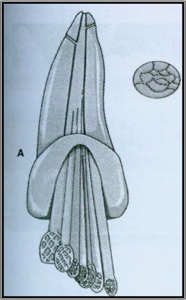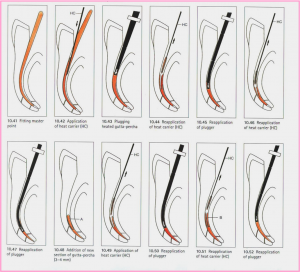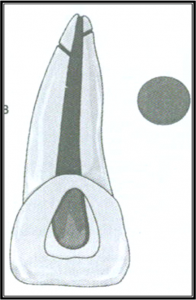According to Grossman
-Lateral condensation method
-Vertical condensation method
-Sectional method
-Compaction method (mcSpadden)
-Metal-core obturation
-Silver-cone method
-Stainless steel file method
-Chemically plasticized gutta-percha
-Injection techniques of obturating canals
-Hydron
-Thermo-plasticized gutta-percha method
-Obtura II, Ultrafil
ACCORDING TO STOCK:
Sectional
Single cone
Multiple cone :cold lateral condensation
warm lateral condensation
Warm vertical condensation
Custom made.
G P with solvents.
Thermal compaction
Injection molded thermo plasticized
Pastes alone.
According to Ingle
Apical third fillings
Light speed simplifill
Dentin-chip
Calcium-hydroxide
Injection or “spiral†filling
Cements
Pastes
Plastics
Calcium phosphate
All the methods use physical characteristics of G.P
i.e plasticity or flow
The Lateral Compaction method uses spreaders and pluggers to force G.P to flow
The Vertical Compaction uses vertical force combined with applied heat to force G.P apically and laterally
Thermoplasticized technique uses heat to increase the plasticity
Chemoplasticized technique –use of solvents like chloroform, eucalyptol to increase G.P viscosity to a fluid state

Lateral compaction method:
Master cone selection :
Is done
-by visual test
-by tactile method
-by radiographs
It is selected based on the final prepared apical size of Root canal.
The master cone should fit snugly to the W.L
Tug back is resistance to removal of the cone.
The fit of the 10 cone is to avoid overfilling of the r.c
Canal preparation:
The canal is dried with paper points .
Residual moisture is removed by rinsing the canal with 95% ethyl alcohol.
Compactor selection Hand
spreader
Finger
The instrument should reach the W.L without binding in the canal
Lentulo spirals
Sealer placement
Reamer
Master cone placement:
Slow insertion of master cone is necessary for thorough sealer distribution and dissipation of trapped air.
Master cone compaction:
After the placement of the master cone, a spreader is inserted along side and is pressed apically.
Then the spreader is disengaged from the cone by rotating it.
Accessory cone is inserted in the space made by spreader.
This process is repeated until the entire canal is filled with G.P cones.
Then the butt end of G.P cones are seared off with a hot instrument followed by vertical compaction with pluggers to adapt the G.P to canal walls.
Temporary restoration is placed in the pulp chamber
Vertical condensation method [warm G.P]
Introduced by Schilder .
This method is used with step-back technique of
root canal preparation.
Objective is to seal lateral and accessory canals and the main root canal.
Here heat carriers and pluggers of different sizes are used
Steps
: Master cone is selected
: Sealer is applied to the canal walls.
: The cone is placed and the coronal end of the cone is cut off with a hot instrument.
: A heat carrier is heated to red hot and is forced into the coronal 1/3rd of G.P.
: A vertical condenser or plugger of suitable size is inserted and vertical pressure is applied to heated G.P to force the plasticized material apically.
: This alternate application of heat carrier and condenser is repeated until the plasticized G.P seals the accessory canals and fills the main canal.
: The remaining portion of canal is plugged with warm sections of additional pieces of G.P.

Advantages:
Excellent seal apically and laterally.
Disadvantage:
Time consuming
Risk of vertical fracture due to undue force
SINGLE CONE TECHNIQUE:
INDICATIONS:
The canal walls are reasonably parallel and primary cone fits snugly in the apical third of the canal.
The canal is too wide and commercially available gutta percha cones will not fit the canal adequately.
Fabrication of a customized gutta-percha cone:
Three or more gutta percha cones are warmed together over a flame and pressed and twisted together into a bundle. The slightly warmed cones are rolled between two sterile glass slabs held at an angle to make a cone with a diameter approximating the size of the canal.
Sectional Method:
In this method a section of a G.P cone is used to fill a section of r.c
STEPS:
The canal wall is coated with sealer
A G.P cone of approximate the size of prepared canal is cut into sections each 3 or 4mm long.
The apical section is mounted on the heated plugger carried into the canal and is pressed vertically.
The plugger is disengaged carefully to prevent dislodging of the section.
The next section is dipped in eucalyptol, is warmed over a flame and is added to previous section under vertical pressure.
Advantages:
Seals apically and laterally
Disadvantages:
1. Time consuming
2. Difficult to retrieve the section of G.P if overfilled
3. Difficult to condense the G.P sections into homogeneous mass leading to voids



